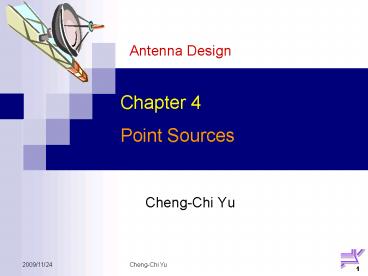Point Sources PowerPoint PPT Presentation
1 / 29
Title: Point Sources
1
Antenna Design
Chapter 4 Point Sources
- Cheng-Chi Yu
2
Contents
- Point source radiators
- Power patterns
- Isotropic sources
- Radiation intensity
- Example of power patterns
- Field patterns
- Phase patterns
3
Point source
- Our observations are made at a sufficient
distance (far field), any antenna, regardless of
its size or complexity, can be represented in
this way by a single point source. - As shown in Fig. 4-1b, if Rgtgtd, Rgtgtb, and Rgtgt?,
the distance d between the two centers has a
negligible effect on the field patterns at the
observation circle. However, the phase patterns
will generally differ, depending on d. As d is
increased, the observed phase shift becomes
larger.
4
Power patterns
- The time rate of energy flow per unit area is the
Poynting vector, or power density (Watt/m2). - For a point source (or in the far field of any
antenna), the Poynting vector S has only a radial
component Sr with no components in either the ?
or ? directions (S? S?0).
5
Power patterns
- A source that radiates energy uniformly in all
directions is an isotropic source. - For a isotropic source, the radial component Sr
of the Poynting vector is independent of ? and ?. - A graph of Sr at a constant radius as a function
of angle is a Poynting vector (or power-density)
pattern, but is usually called a power pattern.
6
Power pattern of isotropic source
- The 3-D power pattern for an isotropic source is
a sphere. In 2-D the pattern is a circle.
7
Absolute power patterns vs.relative power pattern
- Absolute power pattern Sr is expressed in W/m2
- Relative power pattern Sr is expressed in terms
of its value in some reference direction - A relative power pattern with a maximum of unity
is also called a normalized pattern.
8
A power theorem and its application to an
isotropic source
- 4
Sr ? 1/r2
9
Radiation intensity
10
Power theorem
- The total power radiated is given by the integral
of the radiation intensity over a solid angle of
4? steradians. - Power patterns can be expressed in terms of
either the Poynting vector (power density) or the
radiation intensity. - The total radiation power of an isotropic source
is - P 4?Uo (W)
- Where Uo radiation intensity of isotropic
source, W/sr
11
Example of power patterns
- Calculating D of various power patterns
- Unidirectional cosine power pattern
- Bidirectional cosine power pattern
- Sine (doughnut) power pattern
- Sine-squared (doughnut) power pattern
- Unidirectional cosine-squared power pattern
- Pencil beam with minor lobes
12
ltsolgt
- The maximum radiation intensity Um of the
unidirectional cosine source is 4 times the
radiation intensity Uo from an isotropic source
radiation the same total power.
13
14
15
ltsolgt
16
17
(No Transcript)
18
(No Transcript)
19
(No Transcript)
20
- By sufficiently reducing the step size, the
summation can be made as precise as the available
data will allow. - The directivity can be expressed as D 4?/?A
A/a
21
Relation of the Poynting vector S and electric
field of the far field
- For far field (point source)
- Poynting vector radial ( Sr component only )
- Electric field transverses to the wave direction
( E? and E? components only ) and so magnetic
field does. - E and H perpendicular to each other, and in
phase. - E/H Z 377 ?
22
Relation of the Poynting vector S and electric
field of the far field
- The Poynting vector and the electric field at a
point of the far field are related in the same
manner as they are in a plane wave, since, if r
is sufficiently large, a small section of the
spherical wave front may be considered as a
plane. - The relation between the average Poynting vector
and the electric field at a point of the far
field is
23
Field pattern
- A pattern showing the variation of the electric
field intensity at a constant radius r as a
function of angle (? ,? ) is called a field
pattern. - Absolute field pattern the field intensity is
expressed in V/m - Relative field pattern the field intensity is
expressed in units relative to its value in some
reference direction
relative field pattern of the E? component
relative field pattern of the E? component
24
Field pattern
- The magnitudes of both E? and E? of the far field
vary inversely as the distance from the source. - E? and E? may be different functions, F1 and F2,
of the angular coordinates ? and ? , - The relative total power pattern
25
(No Transcript)
26
(No Transcript)
27
(No Transcript)
28
- The polarity of the lobes alternate ( and -)
- When the magnitude of the field of one lobe ()
and the adjacent lobe (-) are equal, the total
field goes to zero, producing a null.
29
(No Transcript)

